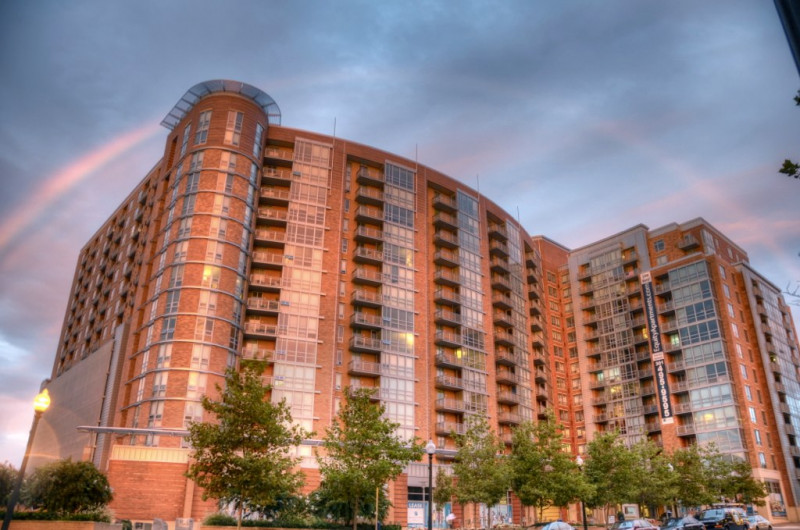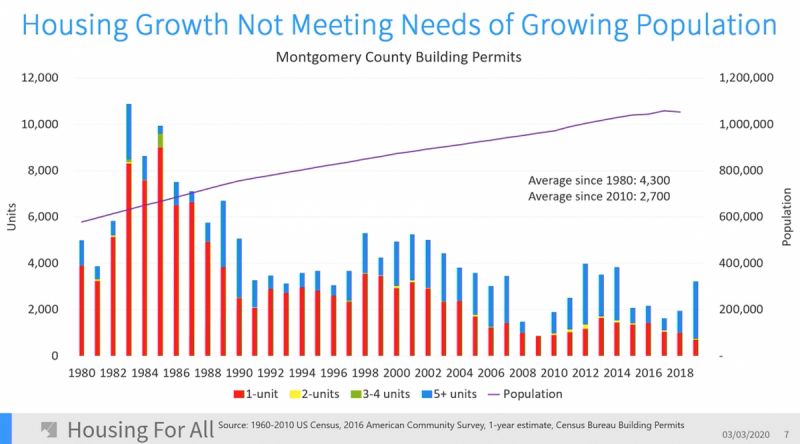Montgomery County weighs its zoning options to tackle a growing population, and a housing shortage

Apartment building in Silver Spring, Md. by Brandon Kopp licensed under Creative Commons.
Montgomery County has seen a steady increase in its population since 1980. But there has also been a decrease in housing production and ownership (especially for those under 35) as well. To add to the housing shortage, about a third of the county’s land is zoned for single-family homes.
To combat this dilemma, the Montgomery County Planning Department has been looking at a multitude of solutions including building more missing middle housing.
During a recent panel discussion called “Big Ideas: Housing for All,” the Montgomery County Planning Department along with Heather Worthington, Minneapolis’s Director of Long Range Planning, talked about what the future of housing could look like for County residents. You can find a full video of the discussion here.
Housing growth chart shown at March 3rd Housing for All Event. by Montgomery County Planning Department.
Big goals, little time
According to target goals set by the county and the Metropolitan Washington Council of Government (MWCOG), the county needs about 320,000 housing units by 2030, to meet population and job demand. The housing also needs to be near activity centers, or high capacity transit, and also a large portion of the housing, about 75% needs to be affordable to low and middle income residents.
Montgomery County land by use. by Montgomery County Planning Department.
Worthington talked about the steps Minneapolis took to address its housing shortage—namely eliminating single family zoning last year. Minneapolis’s plan allowed for a minimum of three units on any city lot, an incremental change that will allow for greater housing supply and diversity citywide. Could Montgomery County do the same with its zoning laws?
Gwen Wright, the director of the Montgomery County Planning Department, demurred, stating that she does not foresee an end to single-family zoning in the county, a change that “would be unrealistic.”
She did, however, admit that the county needs to make changes to accommodate new growth and that “simply doing the old corridor cities, which was the old general plan, isn’t going to work.”
Montgomery County home ownership by age by Montgomery County Planning Department.
Despite her reluctance to eliminate single-family zones, Wright said that the county should try to increase the production of duplexes, triplexes, and small apartments., also referred to as “missing middle” housing. This type of housing is in the middle between the size and scale of single-family homes and large apartment buildings.
Although missing middle housing is denser than single-family homes, there are more homes per acre. And because land in the region is generally expensive, its cost gets spread over multiple housing units. This makes the cost of missing middle housing less expensive and more attainable for middle-income wage earners.
Although Wright did not cite any specific land use changes on the horizon to allow for more missing middle housing, she did show an illustration of the kind of changes she had in mind.
Illustrated Land Use Change to increase housing supply by Montgomery County Planning Department.
These changes are being considered in updates to Montgomery County’s new General Plan, known as Thrive Montgomery 2050 (you can learn more about it here), according to Wright.
What do you think the future of Montgomery County’s built environment should look like? Should the county take steps similar to Minneapolis?
